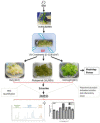UV-C mediated accumulation of pharmacologically significant phytochemicals under light regimes in in vitro culture of Fagonia indica (L.)
- PMID: 33436717
- PMCID: PMC7804141
- DOI: 10.1038/s41598-020-79896-6
UV-C mediated accumulation of pharmacologically significant phytochemicals under light regimes in in vitro culture of Fagonia indica (L.)
Abstract
Fagonia indica (L.) is an important medicinal plant with multitude of therapeutic potentials. Such application has been attributed to the presence of various pharmacological important phytochemicals. However, the inadequate biosynthesis of such metabolites in intact plants has hampered scalable production. Thus, herein, we have established an in vitro based elicitation strategy to enhance such metabolites in callus culture of F. indica. Cultures were exposed to various doses of UV radiation (UV-C) and grown in different photoperiod regimes and their impact was evaluated on biomass accumulation, biosynthesis of phytochemicals along antioxidant expression. Cultures grown under photoperiod (16L/8D h) after exposure to UV-C (5.4 kJ/m2) accumulated optimal biomass (438.3 g/L FW; 16.4 g/L DW), phenolics contents (TPC: 11.8 μgGAE/mg) and flavonoids contents (TFC: 4.05 μgQE/mg). Similarly, HPLC quantification revealed that total production (6.967 μg/mg DW) of phytochemicals wherein kaempferol (1.377 μg/mg DW), apigenin (1.057 μg/mg DW), myricetin (1.022 μg/mg DW) and isorhamnetin (1.022 μg/mg DW) were recorded highly accumulated compounds in cultures at UV-C (5.4 kJ/m2) dose than other UV-C radiations and light regimes.. The antioxidants activities examined as DPPH (92.8%), FRAP (182.3 µM TEAC) and ABTS (489.1 µM TEAC) were also recorded highly expressed by cultures under photoperiod after treatment with UV-C dose 5.4 kJ/m2. Moreover, same cultures also expressed maximum % inhibition towards phospholipase A2 (sPLA2: 35.8%), lipoxygenase (15-LOX: 43.3%) and cyclooxygenases (COX-1: 55.3% and COX-2: 39.9%) with 1.0-, 1.3-, 1.3- and 2.8-fold increased levels as compared with control, respectively. Hence, findings suggest that light and UV can synergistically improve the metabolism of F. indica and could be used to produce such valuable metabolites on commercial scale.
Conflict of interest statement
The authors declare no competing interests.
Figures








Similar articles
-
Chemical Elicitors-Induced Variation in Cellular Biomass, Biosynthesis of Secondary Cell Products, and Antioxidant System in Callus Cultures of Fagonia indica.Molecules. 2021 Oct 20;26(21):6340. doi: 10.3390/molecules26216340. Molecules. 2021. PMID: 34770749 Free PMC article.
-
The interplay between light, plant growth regulators and elicitors on growth and secondary metabolism in cell cultures of Fagonia indica.J Photochem Photobiol B. 2018 Aug;185:153-160. doi: 10.1016/j.jphotobiol.2018.06.002. Epub 2018 Jun 9. J Photochem Photobiol B. 2018. PMID: 29908408
-
Effects of photoperiod regimes and ultraviolet-C radiations on biosynthesis of industrially important lignans and neolignans in cell cultures of Linum usitatissimum L. (Flax).J Photochem Photobiol B. 2017 Feb;167:216-227. doi: 10.1016/j.jphotobiol.2017.01.006. Epub 2017 Jan 7. J Photochem Photobiol B. 2017. PMID: 28088102
-
Fagonia arabica L.: A Review of its Phytochemistry, Pharmacology and Traditional Uses.Comb Chem High Throughput Screen. 2022;25(7):1187-1199. doi: 10.2174/1386207325666210923120957. Comb Chem High Throughput Screen. 2022. PMID: 34554901 Review.
-
Comparative Effects of Different Light Sources on the Production of Key Secondary Metabolites in Plants In Vitro Cultures.Plants (Basel). 2021 Jul 26;10(8):1521. doi: 10.3390/plants10081521. Plants (Basel). 2021. PMID: 34451566 Free PMC article. Review.
Cited by
-
Farm or Lab? A Comparative Study of Oregano's Leaf and Callus Volatile Isolates Chemistry and Cytotoxicity.Plants (Basel). 2023 Mar 28;12(7):1472. doi: 10.3390/plants12071472. Plants (Basel). 2023. PMID: 37050098 Free PMC article.
-
Phytochemical characterization of Thevetia peruviana (lucky nut) bark extracts by GC-MS analysis, along with evaluation of its biological activities, and molecular docking study.Heliyon. 2024 Jun 22;10(13):e33151. doi: 10.1016/j.heliyon.2024.e33151. eCollection 2024 Jul 15. Heliyon. 2024. PMID: 39027575 Free PMC article.
-
Virtual screening, ADME prediction, drug-likeness, and molecular docking analysis of Fagonia indica chemical constituents against antidiabetic targets.Mol Divers. 2025 Apr;29(2):1139-1160. doi: 10.1007/s11030-024-10897-7. Epub 2024 Jul 16. Mol Divers. 2025. PMID: 39012565
-
RED light promotes flavonoid and phenolic accumulation in Cichorium spp. callus culture as anti-candida agent.Sci Rep. 2025 Jan 16;15(1):2194. doi: 10.1038/s41598-024-85099-0. Sci Rep. 2025. PMID: 39820743 Free PMC article.
-
Facile and Green Synthesis of Novel Fluorescent Carbon Quantum Dots and Their Silver Heterostructure: An In Vitro Anticancer Activity and Imaging on Colorectal Carcinoma.ACS Omega. 2023 Jan 27;8(5):4566-4577. doi: 10.1021/acsomega.2c04964. eCollection 2023 Feb 7. ACS Omega. 2023. PMID: 36777585 Free PMC article.
References
-
- Khan T, Khan T, Hano C, Abbasi BH. Effects of chitosan and salicylic acid on the production of pharmacologically attractive secondary metabolites in callus cultures of Fagonia indica. Ind. Crops Prod. 2019;129:525–535. doi: 10.1016/j.indcrop.2018.12.048. - DOI
-
- Farheen R, Siddiqui BS, Mahmood I, Simjee SU, Majeed S. Triterpenoids and triterpenoid saponins from the aerial parts of Fagonia indica Burm. Phytochem. Lett. 2015;13:256–261. doi: 10.1016/j.phytol.2015.07.001. - DOI
MeSH terms
Substances
LinkOut - more resources
Full Text Sources
Other Literature Sources
Medical
Research Materials
Miscellaneous

